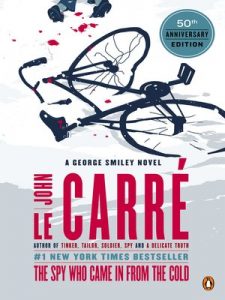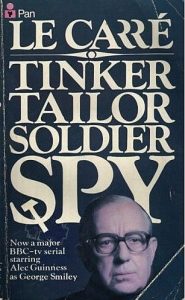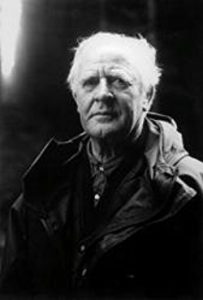David John Moore Cornwell began writing novels about espionage and spies when he was working as a full-time intelligence agent for the British foreign service MI6 – a group whose very existence was not acknowledged by the British government until 1994. He wrote under the pen name John le Carré (“John the Square” in French) only because foreign intelligence service were forbidden to publish under their own names. When his third novel The Spy Who Came in from the Cold (1963) became an international best-seller, he left MI6 to become a full-time author, but obviously part of him has always stayed in the intelligence services – for all of his books concern themselves with secrets, lies, espionage and spycraft.

I’ve enjoyed reading John le Carré from time to time over the years, but only really became entranced with his craft last year, when I happened upon his masterwork Tinker, Tailor, Soldier, Spy and was enthralled with the subtle humor, the detailed characterizations and the incredibly slow pace of a highly suspenseful novel. How, I wondered, did le Carré manage to maintain tension in a novel that focused on a retired old bureaucrat named George Smiley? Smiley is pudgy, dowdy, old-school English, wears thick glasses, stutters when he talks at all, and when he does speak, expounds in soft syllables. He is a paper-pusher, an analyst, and has probably never held a gun in his life. But somehow, John le Carré makes this novel about Smiley crackle with suspense, and the novel kept me glued to the narrative for 100s of pages. It is a thick book, and a very complicated one, and I even know exactly how it ends, but I never once thought of putting it down. How did he do it?
There are many tools le Carré uses to build his work – like a pointillist master painter, every tidy English scene, every spare sentence and every bit of dialogue builds a gradual picture of enormous tension and incredible momentum. I can’t detail the volumes of education I gained about how to improve my own writing when I analyzed Tinker, Tailor, Soldier, Spy and more recently The Russia House, but I can illuminate a few bits of craft that le Carré is teaching me now.
First is the fact that le Carré paints a vivid picture when he describes any character. In fact, le Carré exaggerates when he paints a character. For example, he describes a new character entering a scene with metaphor (not simile) – writing “The first to speak was a distraught, floating man with baby-pink cheeks and baby-clear eyes and a flaxen jacket to match his straggling flaxen hair. His voice floated too” (40).  The vividness of this character description stays with the reader for much of the rest of the book, and from time to time le Carré reinforces it with a slight nod towards the “floating” quality of this man’s look – what is interesting is that this very quality later becomes a plot point, as the Americans distrust this man for his qualities of not-quite-there. le Carré forces readers to see characters as vivid movement on the page, and uses these slightly exaggerated characterizations as a way of burning the character into the reader’s mind, so that there is no doubt what the character is like when he later references them. Painting brightly at the outset allows your characters to last longer in the reader’s mind.
The vividness of this character description stays with the reader for much of the rest of the book, and from time to time le Carré reinforces it with a slight nod towards the “floating” quality of this man’s look – what is interesting is that this very quality later becomes a plot point, as the Americans distrust this man for his qualities of not-quite-there. le Carré forces readers to see characters as vivid movement on the page, and uses these slightly exaggerated characterizations as a way of burning the character into the reader’s mind, so that there is no doubt what the character is like when he later references them. Painting brightly at the outset allows your characters to last longer in the reader’s mind.
The other thing I am beginning to learn from reading closely into le Carré’s work is that a character’s interior life will only take you so far. What I write well, without conscious effort, is interior psycho-drama in which you experience a character’s inner world as they see it, without the intervention of outside elements such as dialogue or even physical descriptions of the surrounding terrain. It is the one thing that literature can do very well that is nearly impossible to replicate in film. For in film, there is no true imaginative interior monologue, no way of seeing the world in terms of interior metaphors and interior voice. There is, of course, the filmic device of a voice-over, but even that doesn’t provide the scrim of dream-like narrative that we as human beings overlay on visceral experience to make a sense-story of life.
We constantly are making a story of everything around us, relating it to other things, and this sense of a world-being-made-of-metaphor is what literature does so very well. When I go out in the world, every person and thing I encounter reminds me of other experiences – I am constantly building a chain of connections between my past experience and my past imaginative life and the life I am currently encountering. I am never just “out of my head” (except perhaps in moments of focused physical attention, such as playing sports or sex). Many great novelists such as DeLillo, Faulkner or McCarthy, spend much of their energy creating a tapestry that resembles this inner life, and that is why their best work is nearly un-filmable.
However, the more I read novelists who are telling a compelling story and are writing for plot, the more I am discovering that good literature can do both psycho-drama and external plot. To establish the point that le Carré is not all about plot and character description, let me first show that le Carré also does the interior psycho-drama thing well. He demonstrates this skill in chapter 7:
She pictured him a waif… lying in semi-darkness on the top berth reserved for luggage, listening to the smokers’ coughing and the grumble of drunks, suffocating from the stink of humanity… while he stared at the appalling things he knew and never spoke of. What kind of hell must that be, she wondered, to be tormented by your own creations? To know that the absolute best you can do in your career is the absolute worst for mankind? (172).
 This passage serves as a good synecdoche for the book’s treatment of inner life. It moves clearly from one character’s apprehension of another in the world, and a clear description of how she pictured this person in their ‘waifish’ environment, to her conception of the character’s mindset and concerns. The passage touches on particulars of experience, then implies dark secrets, and then moves naturally to the broader questions of their shared humanity and the big questions of human morality. It is a solid bit of interior monologue.
This passage serves as a good synecdoche for the book’s treatment of inner life. It moves clearly from one character’s apprehension of another in the world, and a clear description of how she pictured this person in their ‘waifish’ environment, to her conception of the character’s mindset and concerns. The passage touches on particulars of experience, then implies dark secrets, and then moves naturally to the broader questions of their shared humanity and the big questions of human morality. It is a solid bit of interior monologue.
What le Carré is beginning to teach me though is how much more powerful such an complex and emotionally full interior space can be when it is prefaced and impacted by events and physical locations that are clearly described and that have action associated with them that has no “discussion” in the reader’s own head. Motion in the exterior world can be as suspenseful and entrancing as motion in the interior world. In The Russia House, le Carré writes mostly a straightforward narrative full of precise observations, character descriptions that are exacting and precise, and dialogue that sings off the page. Here is one sample passage that demonstrates his skill in this critical exterior narrative:
The woman was trembling. Not only with the hands that held her brown perhaps-bag but also at the neck, for her prim blue dress was finished with a collar of old lace and Landau could see how it shook against her skin and how her skin was actually whiter than the lace. Yet her mouth and jaw were set with determination and her expression commanded him.
“Please sir, you must be very kind and help me,” she said as if there were no choice.
….
What happened next happened quickly, a street-corner transaction, willing seller to willing buyer. The first thing Landau did was look behind her, past her shoulder. He did that for his own preservation as well as hers. But his end of the room was empty, the area dark.
“Got it with you then, have you dear?” he asked, peering down and smiling like a friend.
“Yes.”
What I’m learning from le Carré is that very precise description that does not paint with emotion, but instead paints with detail – every detail in the woman’s description denotes terror, every moment adding fear, and the whole scene creates a moment of enormous suspense for both the reader and the characters. Then, le Carré also adds dialogue that has awkward language, but also implores, finished by a commanding note at the end. Finally, there is the rush to action, coupled with the caution of looking around at the crowd. The dialogue is masterful, because it is so spare, with few adverbs at all. Landau, the character, gives a very English reply – he asks about the manuscript, but the manners he use imply that he is trying to be casual, trying to act as if it is of no great concern. Even though we as readers know that the rest of this 400+ page novel depends upon this scene, and even though both characters act as if their lives depend upon what happens with this manuscript handoff, the exchange is a studied moment of casual conversation. This, for me, demonstrates something I could take to heart: casual “throwaway” moments can be just as dramatic – even more so – than moments that are overwrought with adverbs and emotion.

Overall, what is key to learn here for me is the necessity of moving vividly outside the character’s heads and into the world around them in a forceful way. The action can be constrained – as le Carré demonstrates with finesse in Tinker, Tailor, Soldier, Spy – but it must be external to the protagonist’s head-talk. If the writer makes the external world come to life in a very real way to the reader, then the internal landscape will matter even more when we return to that inner monologue. The truth is in the intersection between this outer world and this inner world – this is where the writer must make their art.
Since I wrote this post, I was inspired to complete my own spy novel, which is a bit of a twist on the Cold War and War on Terror espionage so well described by le Carré. My novel Wilderness of Mirrors will be released in 2021.







